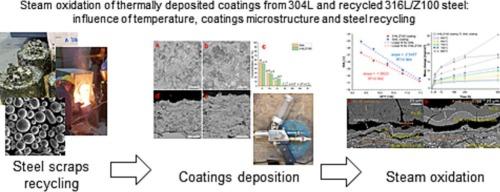Steam oxidation of thermally deposited coatings from 304 L and recycled 316 L/Z100 steels: Influence of temperature, coatings microstructure and steel recycling
IF 5.3
2区 材料科学
Q1 MATERIALS SCIENCE, COATINGS & FILMS
引用次数: 0
Abstract
The application of thermally sprayed stainless steels coatings is a well-established approach to protecting low-alloy steels against high-temperature degradation. In this study, we investigated both: (1) the influence of microstructural features of the coatings and (2) the recycling of stainless steels on the course of high temperature steam oxidation. It was achieved by thermally spraying coatings on C45 steel from 304 L and a new type of 316 L/Z100 steel, obtained as a result of mixed scraps recycling. Steam oxidation tests carried out in the temperature range 600–800 °C for 500 h in pure steam show temperature depended mechanism of oxidation, which was defined and described. The formation of the scales with a multi-layered structure was observed, consisting of Fe2O3, Fe3O4, Cr2O3, Fe- or Cr-rich CrxFex-2O3 and (Mn,Cr,Ni)xFe3-xO4 spinels. The relative ratio of the phases and their presence in particular scale layers varied depending on the material studied and the exposure temperature. The key findings are that recycling of steel deposited as protective coating has led to an unintended change in Si and C concentrations, which may affects course of oxidation. Also, the microstructure of the initial coatings, consisting of porosity and a significant volume of oxides formed during steel deposition, inhibits the formation of a homogeneous layer of protective Cr2O3. As a result, the established values of oxidation kinetics constants (in range of 8.55E-12 to 1.50E-10 g3·cm−6·s−1 for 316 L/Z100 and 2,71E-12 to 4.60E-10 g3·cm−6·s−1 for 304 L coatings) and oxidation activation energies (156.4 kJ·mol−1 for 316 L/Z100 and 211.5 kJ·mol−1 for 304 L coatings) differ significantly from those of bulk steels under the same conditions reported in the literature.

304 L 和回收的 316 L/Z100 钢热沉积涂层的蒸汽氧化:温度、涂层微观结构和钢回收的影响
应用热喷涂不锈钢涂层是防止低合金钢高温降解的一种行之有效的方法。在这项研究中,我们对以下两个方面进行了研究:(1) 涂层微观结构特征的影响;(2) 不锈钢的回收利用对高温蒸汽氧化过程的影响。我们在 304 L 的 C45 钢和一种新型 316 L/Z100 钢上热喷涂了涂层,这种钢是混合废料回收的结果。在 600-800 °C 的温度范围内,在纯蒸汽中进行了 500 小时的蒸汽氧化试验,结果表明,氧化机制与温度有关。观察到形成了具有多层结构的鳞片,由 Fe2O3、Fe3O4、Cr2O3、富含 Fe 或 Cr 的 CrxFex-2O3 和 (Mn,Cr,Ni)xFe3-xO4 尖晶石组成。这些相的相对比例及其在特定鳞片层中的存在随研究材料和暴露温度的不同而变化。研究的主要发现是,作为保护层沉积的钢的回收利用导致了硅和碳浓度的意外变化,这可能会影响氧化过程。此外,初始涂层的微观结构包括多孔性和在钢沉积过程中形成的大量氧化物,这阻碍了均匀的 Cr2O3 保护层的形成。因此,氧化动力学常数(316 L/Z100 为 8.55E-12 至 1.50E-10 g3-cm-6-s-1,304 L 涂层为 2,71E-12 至 4.60E-10 g3-cm-6-s-1)和氧化活化能(316 L/Z100 为 156.4 kJ-mol-1,304 L 涂层为 211.5 kJ-mol-1)的既定值与文献报道的相同条件下的块状钢的氧化动力学常数和氧化活化能有很大不同。
本文章由计算机程序翻译,如有差异,请以英文原文为准。
求助全文
约1分钟内获得全文
求助全文
来源期刊

Surface & Coatings Technology
工程技术-材料科学:膜
CiteScore
10.00
自引率
11.10%
发文量
921
审稿时长
19 days
期刊介绍:
Surface and Coatings Technology is an international archival journal publishing scientific papers on significant developments in surface and interface engineering to modify and improve the surface properties of materials for protection in demanding contact conditions or aggressive environments, or for enhanced functional performance. Contributions range from original scientific articles concerned with fundamental and applied aspects of research or direct applications of metallic, inorganic, organic and composite coatings, to invited reviews of current technology in specific areas. Papers submitted to this journal are expected to be in line with the following aspects in processes, and properties/performance:
A. Processes: Physical and chemical vapour deposition techniques, thermal and plasma spraying, surface modification by directed energy techniques such as ion, electron and laser beams, thermo-chemical treatment, wet chemical and electrochemical processes such as plating, sol-gel coating, anodization, plasma electrolytic oxidation, etc., but excluding painting.
B. Properties/performance: friction performance, wear resistance (e.g., abrasion, erosion, fretting, etc), corrosion and oxidation resistance, thermal protection, diffusion resistance, hydrophilicity/hydrophobicity, and properties relevant to smart materials behaviour and enhanced multifunctional performance for environmental, energy and medical applications, but excluding device aspects.
 求助内容:
求助内容: 应助结果提醒方式:
应助结果提醒方式:


